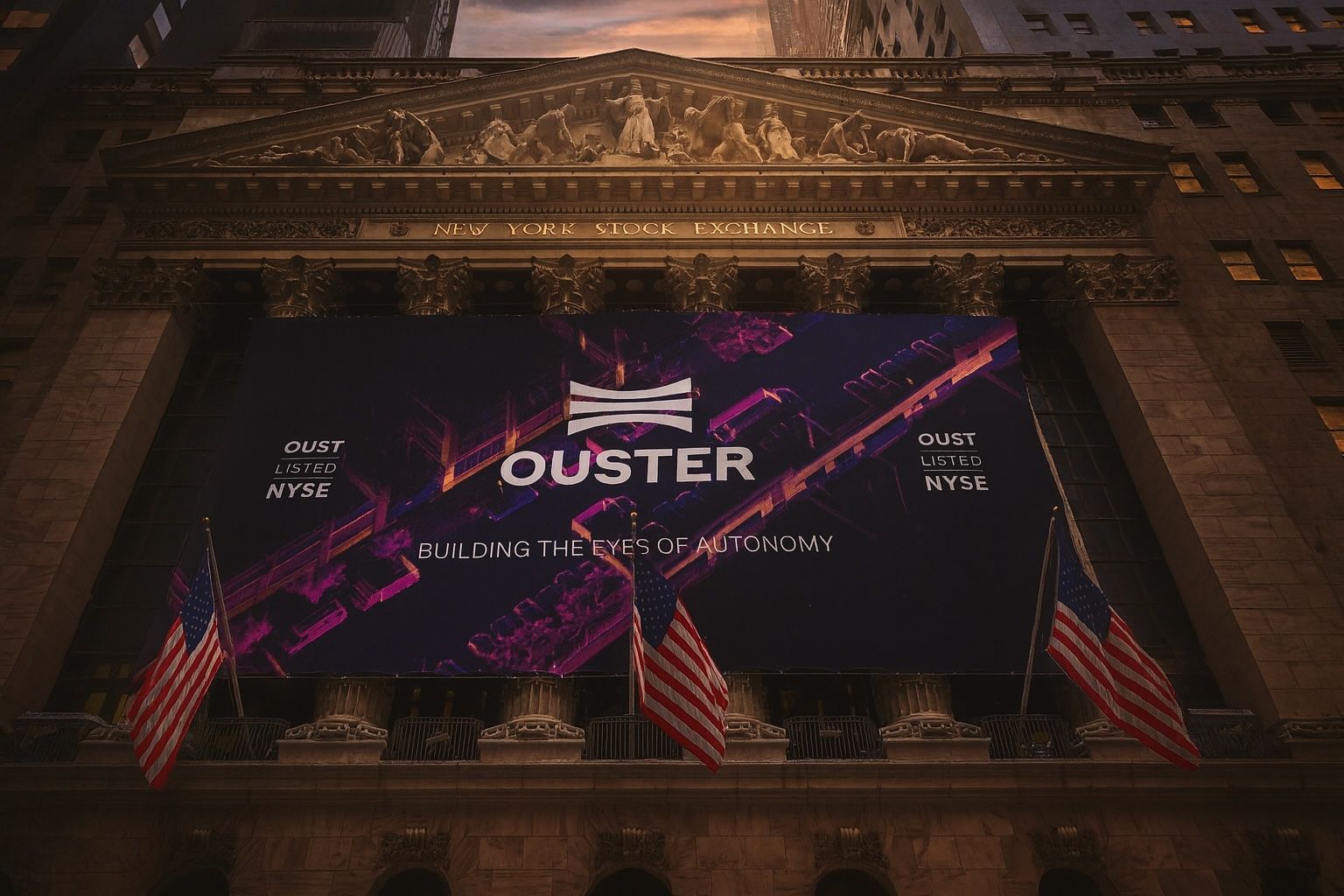- Ouster (NASDAQ: OUST) shares have surged to around $36 – a 52-week high – after climbing over 470% from their yearly low of $6.34 [1], vastly outperforming the broader market.
- The LiDAR sensor maker’s stock jumped double-digits in recent days amid strong sales growth and strategic deals, including a new security partnership and a Fortune 500 global rollout, signaling rising demand for its technology.
- Wall Street is upbeat yet cautious: Cantor Fitzgerald calls Ouster “fundamentally best-positioned” in the LiDAR industry [2] due to superior revenue and margins, but notes the stock now trades above fair value after its rally [3].
- Major developments – such as Ouster’s partnership with security firm Constellis to integrate its AI-driven lidar into defense platforms [4] – have bolstered investor confidence, as the company heads into its Q3 earnings report on November 4, 2025 [5].
- Experts see growth ahead in autonomous vehicles and smart infrastructure that could fuel Ouster’s long-term prospects, though fierce competition and high volatility (beta ~2.7) mean the ride may be bumpy [6].
Stock Soars on Strong Momentum
Ouster’s stock has been on a tear, recently hitting a high of $36.30 per share – a new 52-week peak [7]. This milestone caps a stunning run for the San Francisco-based LiDAR manufacturer: shares have skyrocketed roughly 338% in the past year and an astonishing 473% above their 52-week low of $6.34 [8]. By comparison, the S&P 500 index rose only about 8.8% year-to-date [9], highlighting Ouster’s dramatic outperformance. The stock’s 50-day moving average is around $29.6 and it has more than tripled its value over six months [10], reflecting sustained bullish momentum. However, the beta of ~2.7 indicates OUSTER shares are far more volatile than the market [11], so sharp swings (up or down) have been common – a trend investors should keep in mind.
This week in particular saw a sharp jump of about 9–10% on Tuesday alone, with OUST closing near $34 after touching intraday highs in the mid-$33 range [12] [13]. That spike continued an upswing from the prior trading session, when the stock leapt from ~$28 to over $31. Trading volumes have been brisk, though Tuesday’s volume was actually slightly below average as some traders sat out the rally [14]. Still, market enthusiasm is clearly running high, pushing Ouster to levels not seen in years (the stock is now at a multi-year high, factoring in a reverse split and past declines).
What’s Fueling the Rally?
Several catalysts have coalesced to drive Ouster’s remarkable run. First and foremost, the company’s financial performance is improving. In the second quarter of 2025, Ouster delivered revenue of $35.05 million, beating analyst forecasts of $33.57M [15] (about a 4% surprise). This marked roughly 30% year-over-year growth in sales [16], as demand for its digital lidar sensors accelerates. While the Q2 earnings report did show a net loss (EPS of –$0.38 vs. –$0.29 expected) [17], investors have focused on the top-line strength and gross margin gains. GAAP gross margin hit 45% in Q2, up sharply from the prior year [18], indicating improving efficiency even as the company scales production.
Ouster’s operational milestones and partnerships have also stoked optimism. In mid-September, Ouster announced a strategic partnership with Constellis, a major security and defense services firm, to integrate Ouster’s Gemini lidar-based AI software into Constellis’s LEXSO security platform [19]. The collaboration will deploy Ouster’s digital LiDAR sensors and real-time 3D perception software to enhance threat detection and situational awareness in high-security environments [20] [21]. “Together, we’re turning disparate signals into actionable intelligence… raising detection performance, reducing false alarms and accelerating response across mission-critical environments,” said Constellis CEO Terry Ryan of the Ouster deal [22]. Ouster’s CEO Angus Pacala added that the deployment “underscores how lidar-powered AI can transform situational awareness and decision-making for the most demanding security environments” [23]. News of this partnership showcased Ouster’s expansion beyond autonomous vehicles into “physical AI” security solutions, and has been seen as validation of its technology in a new $ market.
Around the same time, a Fortune 500 technology company moved from a pilot to a global rollout of Ouster sensors across 500+ retail locations in 24 countries [24] – a massive deployment that underscores commercial confidence in Ouster’s LiDAR at scale. While the client wasn’t named due to confidentiality, analysts noted this as a “major commercial rollout” that could bolster Ouster’s brand and revenue pipeline [25] [26]. It’s a concrete sign that LiDAR adoption is gaining traction beyond test projects and into real-world operations, which has given investors a compelling growth narrative.
Earlier in the year, Ouster scored a huge credibility boost in the government arena: its flagship OS1 sensor became the first high-resolution 3D LiDAR to receive U.S. Department of Defense approval for use on unmanned drones [27]. This “big-time win with the DoD” (as one analyst put it) sent the stock soaring ~27% when announced [28] [29]. Cantor Fitzgerald highlighted the DoD certification as a “material differentiator”, estimating competitors are at least a year behind in achieving similar clearance [30]. This unique status opens the door for Ouster’s tech in defense and aerospace projects, giving it an edge in a niche yet potentially lucrative market.
Ouster has also been expanding in industrial and smart infrastructure verticals. In May, the company secured a multimillion-dollar supply agreement with Komatsu to provide 3D lidar sensors for autonomous mining equipment [31] – upgrading heavy machinery from legacy 2D sensors to Ouster’s more advanced 3D units. And in the smart cities arena, Ouster’s BlueCity traffic management platform (which combines its digital lidars with AI analytics) has now been deployed at over 400 intersections worldwide [32], including powering an entire lidar-based traffic network in Chattanooga, Tennessee [33]. These wins illustrate how Ouster’s technology is not just about self-driving cars; it’s enabling automation in warehouses, robots, mines, drones, and city streets, diversifying the company’s opportunities.
Analyst Insights: Praise and Prudence
The breathtaking rally in OUST has drawn plenty of attention – and mixed reactions – from market analysts. Many analysts are bullish on Ouster’s fundamentals and long-term potential, but some warn that the stock’s valuation may have gotten ahead of itself in the short run.
Notably, Cantor Fitzgerald raised its price target on Ouster to $30 (from $19) in August [34], after the strong Q2 results and positive business developments. Cantor’s analysts wrote that Ouster is “fundamentally the best-positioned” company in the LiDAR space, generating higher revenue and better margins than its peers [35]. They pointed to Ouster’s healthy 42% gross margin and 26% revenue growth [36], as well as its impressive scale – over 113,000 sensors shipped to date, including 5,500 in just Q2 2025 [37]. The firm also noted an encouraging trend in Ouster’s customer base: automotive-related revenue surged and became the second-largest vertical in Q2, signaling traction in self-driving vehicle deployments [38]. All these factors underpin Cantor’s confidence in Ouster’s competitive edge.
At the same time, Cantor kept a “Neutral” rating despite lifting the target price [39] [40]. Why neutral on a stock that’s booming? In their view, OUST’s meteoric rise had stretched the valuation. By mid-August, shares had more than doubled year-to-date (up 128% vs. S&P’s ~9% gain) [41], and the stock was “trading above its fair value” according to Cantor’s models [42]. That cautious stance seems prescient: with the latest run to ~$36, Ouster now trades above Cantor’s $30 target, suggesting limited near-term upside unless new information justifies a higher valuation.
Other analysts have offered a range of price targets. Market consensus targets average around $35–36 for OUST [43], essentially where the stock is now. Reported 12-month forecasts span from about $30 on the low end to as high as $50 [44] for the most optimistic outlook. For example, TipRanks data shows an average ~$35 target with a $50 high estimate [45]. This implies that while some bulls see more room for growth (nearly 40% upside in the best case) [46], many analysts think Ouster’s current price already factors in much of its foreseeable progress. Indeed, one recent analysis in Seeking Alpha argued that Ouster’s AI and LiDAR advantages might be “already priced in,” cautioning that the stock had become “categorically expensive” after its run-up [47].
It’s also worth noting that insiders have taken advantage of the rally. CEO Angus Pacala and other executives sold chunks of OUST stock in September around the mid-$28 level [48] [49]. Such insider sales – Pacala trimmed about 3.6% of his stake [50] [51] – don’t necessarily signal trouble, but they do suggest management felt it was a reasonable time to realize some gains. Insiders still hold roughly 5–6% of Ouster’s shares [52] [53], and institutional ownership is near 49% [54], indicating a mix of retail enthusiasm and large-holder confidence in the company.
Tech and Market Context: LiDAR’s Rising Tide
Ouster’s fortunes are tied to the broader LiDAR industry boom. LiDAR – which stands for Light Detection and Ranging – uses laser pulses to create precise 3D maps of the environment. It’s a critical technology for autonomous vehicles, robotics, drones, and smart infrastructure, enabling machines to “see” and navigate the world around them. After a few rocky years, the LiDAR sector is now gaining real commercial momentum, as evidenced by Ouster’s recent deals and those of its rivals.
Importantly, Ouster itself grew in stature by consolidating the industry – it merged with former competitor Velodyne in 2023, uniting two leading LiDAR makers under the Ouster name. This merger helped Ouster eliminate a key rival, expand its product portfolio (spinning and solid-state lidar offerings), and achieve greater economies of scale in a market that had perhaps too many small players. The combined company emerged as one of the best-capitalized Western LiDAR specialists, at a time when Chinese LiDAR companies (like Hesai) are also fiercely competing globally [55] [56]. This competitive backdrop means Ouster has to keep investing in innovation – like its new Gemini AI software platform and the BlueCity traffic system – to stay ahead of both well-funded foreign competitors and automotive supplier incumbents developing sensing tech. Analysts caution that intensifying competition from Chinese firms and legacy sensor providers remains a risk factor [57], even with Ouster’s current lead in some areas.
The market opportunity for LiDAR is broad and growing. Beyond self-driving cars (which major automakers and tech companies continue to develop), there is surging interest in using 3D sensors for industrial automation, warehouse robots, delivery drones, mapping, security, and smart city applications. Ouster’s recent wins – from mining trucks to retail stores to city intersections – exemplify how lidar is being adopted in diverse settings. One analysis pegged the “smart infrastructure” segment of the LiDAR market at around $19 billion [58], underlining the significant revenue pool Ouster can tap into as more cities and enterprises upgrade their systems with sensor intelligence.
To capitalize on this trend, Ouster has branded its approach as “Physical AI” – essentially the fusion of advanced sensors with artificial intelligence software to enable real-time decision-making in the physical world [59] [60]. By offering not just the lidar hardware but also the perception software (like Gemini) that interprets the data, Ouster aims to provide end-to-end solutions. This could deepen its moat and boost recurring software revenue over time, complementing the hardware sales.
Forecasts and Investor Outlook
Looking ahead, expectations are rising for Ouster’s future performance. The company’s own guidance for the upcoming quarter (Q3 2025) is revenue of $35–38 million [61], which would mark continued solid growth. Investors will get the official Q3 numbers and an update on November 4, 2025, when Ouster holds its earnings call [62]. If Ouster meets or beats those targets – and shows progress toward narrowing its losses – it could further bolster the bull case. Conversely, any slip in execution or cautious commentary about 2026 could test the stock’s lofty valuation.
Over the long term, many analysts and models project robust growth for Ouster, albeit from a small base. One forecast anticipates Ouster reaching $335.6 million in annual revenue by 2028 with about $30 million in net earnings [63] (versus ~$100M revenue and negative $92M earnings now [64]). That implies a rapid ~39% compound annual growth in sales, as adoption of lidar ramps up. Under those assumptions, Ouster’s fair value could be around $35 per share [65], roughly where the market has priced it lately. In other words, the stock’s current price is baking in a continuation of high growth through the decade, and perhaps the expectation that Ouster will turn profitable on that timeframe. Any acceleration (or deceleration) of LiDAR demand, or wins against (or losses to) competitors, will likely shift these forecasts.
It’s worth noting that predictions on OUST vary widely – reflecting both the high promise and high uncertainty in the lidar sector. In fact, a range of community and analyst valuations span from as low as $5 to over $40 per share for Ouster [66], depending on differing views of the company’s risk factors and market capture. Bulls argue that if Ouster cements itself as a top sensor supplier for autonomous vehicles or smart cities, the upside could be enormous (especially given some pure-play peers have multi-billion valuations). Bears, however, point out that Ouster is still losing money, operates in an emerging industry that has seen hype fizzle before, and must continue to out-innovate larger tech and automotive players. They also note the stock’s intense volatility, which can be a double-edged sword – quick to surge on good news, and quick to plunge on any setbacks.
For now, Ouster’s trajectory has been undeniably impressive. The company has navigated 2025 with strong execution, turning pilot projects into real deployments and pushing its technology into new domains. This has translated into tangible shareholder rewards, as seen in the stock’s 5x climb over the past year [67]. The key question for investors is whether Ouster can keep up the pace: Can it maintain high growth and approach profitability before the competition catches up? The upcoming earnings and guidance updates will provide important clues.
Bottom Line
Ouster, Inc. has emerged as a standout performer in 2025, with its stock price hitting new highs on the back of accelerating revenue, high-profile partnerships, and the broader excitement around LiDAR technology. The company’s digital lidar sensors – and the “physical AI” software stack built around them – are gaining traction in everything from self-driving cars to security systems to smart cities. This has put Ouster at the forefront of a potential LiDAR revolution in how machines perceive the world.
Investors are clearly taking notice of Ouster’s progress, but they are also trying to discern how much of the good news is already priced into the stock. Analyst opinions are mixed: while some have raised targets and praise Ouster’s leadership in a growing industry [68], others urge caution given the stock’s massive run-up and still-lossmaking status [69]. The next few months will be critical. If Ouster continues to deliver strong results and wins new contracts, it could justify the bulls’ optimism – and possibly drive the stock even higher, especially since a few analysts think it could go toward $50 [70]. On the other hand, any hiccup or signs of slowing momentum could prompt a reality check and some profit-taking in this high-flyer.
For now, OUST remains one of the year’s most eye-catching tech stocks, riding the wave of autonomous tech enthusiasm. With a market cap around $1.8 billion [71] [72], the company has grown into a significant player in the sensor market, but still has substantial room to expand if it can seize the multibillion-dollar opportunities in its path. Potential investors should keep both the excitement and the risks in view – Ouster is growing fast in a hot field, yet the road to widespread lidar adoption (and consistent profitability) is still being paved. As the company prepares for its next earnings reveal on Nov. 4 [73], all eyes will be on whether Ouster can keep lighting the way forward in the autonomous age.
Sources: Ouster press releases and financials [74] [75]; Investing.com news reports [76] [77] [78]; Cantor Fitzgerald analyst commentary [79] [80]; MarketBeat and SimplyWallSt analyses [81] [82]; ExecutiveBiz (Constellis partnership details) [83] [84].
References
1. za.investing.com, 2. www.investing.com, 3. www.investing.com, 4. za.investing.com, 5. www.stocktitan.net, 6. za.investing.com, 7. za.investing.com, 8. za.investing.com, 9. www.investing.com, 10. za.investing.com, 11. za.investing.com, 12. www.marketbeat.com, 13. www.marketbeat.com, 14. www.marketbeat.com, 15. za.investing.com, 16. investors.ouster.com, 17. za.investing.com, 18. investors.ouster.com, 19. za.investing.com, 20. www.executivebiz.com, 21. www.executivebiz.com, 22. www.executivebiz.com, 23. www.executivebiz.com, 24. simplywall.st, 25. simplywall.st, 26. simplywall.st, 27. www.investing.com, 28. www.marketbeat.com, 29. www.marketbeat.com, 30. www.investing.com, 31. www.stocktitan.net, 32. www.stocktitan.net, 33. www.stocktitan.net, 34. www.investing.com, 35. www.investing.com, 36. www.investing.com, 37. www.investing.com, 38. www.investing.com, 39. www.investing.com, 40. www.investing.com, 41. www.investing.com, 42. www.investing.com, 43. fintel.io, 44. fintel.io, 45. www.tipranks.com, 46. fintel.io, 47. seekingalpha.com, 48. www.marketbeat.com, 49. www.marketbeat.com, 50. www.marketbeat.com, 51. www.marketbeat.com, 52. www.marketbeat.com, 53. www.stocktitan.net, 54. www.stocktitan.net, 55. simplywall.st, 56. simplywall.st, 57. simplywall.st, 58. finance.yahoo.com, 59. www.stocktitan.net, 60. www.stocktitan.net, 61. www.stocktitan.net, 62. www.stocktitan.net, 63. simplywall.st, 64. simplywall.st, 65. simplywall.st, 66. simplywall.st, 67. za.investing.com, 68. www.investing.com, 69. www.investing.com, 70. fintel.io, 71. www.stocktitan.net, 72. www.stocktitan.net, 73. www.stocktitan.net, 74. investors.ouster.com, 75. www.stocktitan.net, 76. za.investing.com, 77. za.investing.com, 78. za.investing.com, 79. www.investing.com, 80. www.investing.com, 81. www.marketbeat.com, 82. simplywall.st, 83. www.executivebiz.com, 84. www.executivebiz.com







